Waldorf News
High-tech vs. no-tech: D.C. area schools take opposite approaches to education
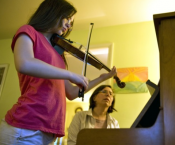
By CECILIA KANG
The sixth-graders are lighting up the room with their MacBook Airs, flipped open to Google, Wikipedia and YouTube for a physics assignment. Their classroom is decked out with touch-screen whiteboards, tablets and powerful WiFi connections able to handle a school full of children online at once.
“Cool!” Nina Jenkins says, opening links to Web sites that take her deeper into the study of acoustics. She’s making a small drum by hand and will record herself playing it on iMovie. At the end, she’ll write her reflections in 140 characters or less — in a tweet.
In the same week, about a dozen miles away, another set of sixth-graders is on a similar lesson. Only they are in a spare, birch-hued classroom that looks like a throwback to the Norman Rockwell era. There are no computers here. The only tools being used are spoons and forks tied together with purple yarn. The students listen to the clang of utensils change pitch as the yarn is shortened and lengthened. Nina Auslander-Padgham’s eyes widen with the discovery, and she rushes back to her wooden desk to write her reflections on the blank pages of a red hardcover journal.
At these two Washington area private schools, separated only by a 20-minute drive, the two Ninas may as well exist on different planets. They are growing up on opposite sides of a gaping educational divide formed not by the usual school fissures of economics and race. Theirs is a division wrought by technology.
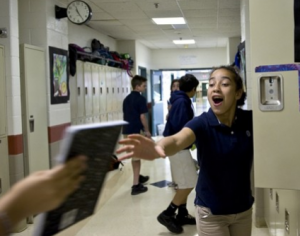 The Flint Hill School in Oakton is ultra-wired. Apple hails it as a model for its embrace of devices. Teachers here believe technology immersion will make their students more excited about learning and better prepared for college and careers. So they’ve given each child a device — starting with an iPad for every preschooler and MacBook Airs starting in the fifth grade.
The Flint Hill School in Oakton is ultra-wired. Apple hails it as a model for its embrace of devices. Teachers here believe technology immersion will make their students more excited about learning and better prepared for college and careers. So they’ve given each child a device — starting with an iPad for every preschooler and MacBook Airs starting in the fifth grade.
“Tech is like oxygen,” said Shannan Schuster, Flint Hill’s dean of faculty. “It’s all around us, so why wouldn’t we try to get our children started early?”
The Washington Waldorf School in Bethesda is trying its best to stay unplugged. Its teachers think technology is a distraction and overhyped. They believe children are better taught through real-world experiences in the school’s vegetable garden and woodwork shop. Educators here fear that the immediate gratification of texts and Wikipedia threatens face-to-face communication and original thinking, so they ban cellphones, laptops and tablets and require students to hand-write papers until high school.
“What is the rush?” said Natalie Adams, Washington Waldorf’s faculty chair. “There is a time and a place for technology, but children need to first relate to the physical world around them.”
The independent pre-K-to-12 schools are able to make such stark choices because of the flexibility their private boards and budgets allow them. And though they may represent the extremes, their experiences offer touchstones for parents and educators unsure about the promises of learning through technology for this ultra-connected generation.
Amid a sweeping fancy for mobile devices, Americans are wrestling to understand how technology is shaping their lives. And nowhere is that more evident than in the debate over how much we should expose our children to technology.
For parents, there are no definitive answers. Academic research seems to provide contradictory findings. And the federal government has barely begun to grapple with the effects of technology on children, even as it spends billions of dollars to bring broadband Internet to schools and libraries, and offers big tax breaks for educational software and gadgets by Apple and Microsoft.
“We have to stop and think if we are embracing technology just because it is there and new or if it is the best tool for what we want to accomplish,” said Michael Rich, director of the Center on Child Media and Health at Harvard University. “Sometimes the answer is that an iPad is great, but does it really do a better job than a hunk of clay or paper?”
Help or hindrance
Recent studies show children are being exposed to far more media than any previous generation, largely because of the explosion of smartphones and tablets in the home.
But is this healthy for their development?
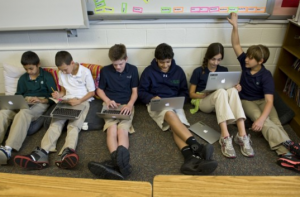 Some research shows that software programs such as smartphone applications help improve kids’ vocabulary and math. Children ages 3 to 7 who used an app called Martha Speaks increased their vocabulary by as much as 31 percent in two weeks, according to a 2010 study commissioned by PBS. Some educators say technology allows them to personalize teaching plans and offer free online tutoring, a way to break free from cookie-cutter lessons that don’t resonate with every student.
Some research shows that software programs such as smartphone applications help improve kids’ vocabulary and math. Children ages 3 to 7 who used an app called Martha Speaks increased their vocabulary by as much as 31 percent in two weeks, according to a 2010 study commissioned by PBS. Some educators say technology allows them to personalize teaching plans and offer free online tutoring, a way to break free from cookie-cutter lessons that don’t resonate with every student.
On the other hand, child development experts say children are developing shorter attention spans and multi-tasking too much online — habits that will become more ingrained over time. Technology is changing the way kids learn, too; ideas aren’t as original when cobbled together through Google searches and recycled from opinion blogs, teachers at Waldorf say. And students are increasingly skipping over basic disciplines such as spelling and handwriting — practices that have diminished in importance in the workplace but are still key to wiring the young brain, some child-development experts say.
In February, the Education Department , along with the Federal Communications Commission, called for all American classrooms to adopt digital textbooks by 2017. The goal was inspired by South Korea — which is now rethinking the merits of the online books over paper textbooks.
“I’m calling for investments in educational technology that will help create digital tutors that are as effective as personal tutors, educational software as compelling as the best video game,” President Obama said last year while touring a tech-focused Boston school.
At the same time, the department has found that past investments in educational technology have not paid off. In a 2009 report, it found that students who used math and reading software over a one-year period scored the same on tests as peers who did not use the programs.
The two Ninas
The contrasting approaches on technology show a sharp dividing line between the two suburban Washington schools — and the two Ninas’ families.
Otherwise, the girls would find much in common. They are fans of Adele’s moody ballads and the book “The Hunger Games.” They are svelte and athletic but haven’t outgrown pinks and pastels. They are thoughtful and observant students; they won’t be the first to speak up in class but aren’t afraid to express their views.
But by 8 a.m., when they enter the front doors of their schools, one has had access to a dizzying array of devices while the other’s exposure is limited to the car radio. Flint Hill’s Nina Jenkins, 11, has a cellphone and laptop. In her Alexandria home on an acre of forested land, Nina also shares a family computer, Wii and XBox game consoles, and a Kindle Fire tablet. It’s a lot, her parents admit. Nina once stayed up until 2 a.m. playing the social gaming app Words with Friends. At Nina’s 11th-birthday party, her mom confiscated cellphones because Nina and her friends were spending too much time texting.
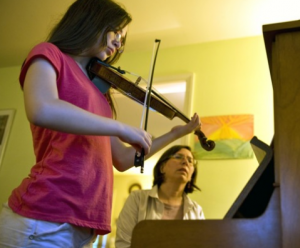 “We are laid-back and trust our children,” Rebecca Jenkins said. “But there are definitely times when I have to stay on top of them.”
“We are laid-back and trust our children,” Rebecca Jenkins said. “But there are definitely times when I have to stay on top of them.”
Monitoring screen time didn’t work for the Auslander-Padghams. Two years ago, on an unusually warm winter afternoon, Nina Auslander-Padgham and her younger brother were battling over the family laptop. They were irritable and moody. The sun was shining, and neither had stepped foot outside into their expansive Bethesda back yard, despite the trampoline and large wooden play set. It was an epiphany for her parents, Bonnie and Jon. All technology had to go.
Their decision has put them in the minority. Six in 10 children older than 9 own a cellphone, according to the Pew Internet & American Life Project. Teens text 60 times a day and four in 10 use video chats, according to Pew. Kids 8 to 18 years old spend about 10.5 hours a day in front of a computer, television or mobile device, up from 7.5 hours a decade ago, according to the Kaiser Family Foundation.
The Auslander-Padghams sometimes struggle to keep technology out of their kids’ lives. When Nina turned 12 in March, she begged for an iPhone, something many of her friends had already. Her parents compromised with a purple digital music player that doesn’t connect to the Internet.
“There is definitely leakage,” her father said. “We know we can’t resist forever.”
Flint Hill
Both Ninas are on a track to succeed, if the academic performance of their schools is any measure.
Seniors at Washington Waldorf and Flint Hill score in the mid- to high 600s on each part of the SAT. They are going to elite colleges such as Stanford, Yale and the University of Virginia — which is not uncommon in the highly educated Washington region.
Flint Hill charges up to $31,000 for a year of high school, which is at the higher end of local private school tuitions. According to the school’s Web site, those fees come with the Apple laptop.
The school, which serves 1,100 students on two campuses totaling 50 acres, launched its emphasis on technology nearly a decade ago. Children are given a lot of independence, able to use their laptops to send e-mails or instant messages even when a teacher is lecturing.
Students in Schuster’s sixth-grade math class can re-watch lectures on their teacher’s YouTube channel. Test grades are immediately posted online for parents to see. Dictionaries are online. Card catalogs are long gone.
Nina Jenkins can’t remember the last time she wrote more than two paragraphs by hand.
On this day in her math class, she is watching her teacher work out an algebra problem on a Promethean smartboard, which has a touch screen that can save a teacher’s work. In her uniform of white and navy blue, Nina writes out the solution on a work sheet. Her laptop is open, too — flashing alerts for iChat messages and e-mails.
She is tempted to check if her partner has added to a joint book project on Google Docs.
As her teacher moves to the next math equation, Nina’s finger hovers over her mouse pad. She weighs what deserves more attention: the math problem or the book project.
This time, math wins.
“I”ll read it later, I guess,” she says, shutting the laptop and placing her work sheet on the laptop’s cover.
Add up those kinds of choices and you raise independent thinkers, according to Flint Hill’s philosophy. Since she entered the school two years ago, Nina has blossomed into a creative and inquisitive student, her parents and teachers say. And yet she still recognizes the value of the pen and paper. She prefers to write poetry by hand.
“I guess you can say it’s more special,” she said.
“She needs an environment that lets her figure out her own style of learning,” her mother said.
All those options can be tempting distractions, some educators say. Half of children 8 to 18 say they are on the Internet, watch TV or use some form of other media while doing homework, according to a 2009 Kaiser Family Foundation study. That makes education experts wonder how much information children are retaining.
“These children are being taught to jump from one topic to the next, and its changing the circuitry of their brains,” said Jim Steyer, president of Common Sense Media, a public interest group that advocates for media safety for children.
Washington Waldorf
Washington Waldorf is less than a quarter of the size of Flint Hill, with 240 students. Parents pay up to $23,000 for tuition. The only technology learning is in a small lab of about a dozen computers.
A good number of the school’s alumni have made careers in the arts, including national symphonies and prominent ballet companies.
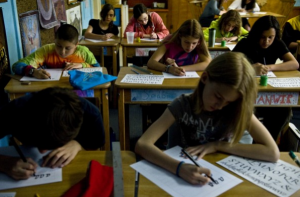 The hallways are quieter and have less bustle than Flint Hill. And classrooms look more traditional, with desks arranged in neat rows, each supplied with a ruler and colored pencils. When a ceiling leak soaked the card catalog this year, the librarian saved the files by ironing each one dry.
The hallways are quieter and have less bustle than Flint Hill. And classrooms look more traditional, with desks arranged in neat rows, each supplied with a ruler and colored pencils. When a ceiling leak soaked the card catalog this year, the librarian saved the files by ironing each one dry.
This morning, Nina Auslander-Padgham’s teacher paces back and forth in front of the students with a history book opened on a music stand. “Medieval History” is written in calligraphy on the chalkboard.
Nina is rapt in attention. She raises her hand to describe the Bedouin tribes of the time.
“They are known for their hospitality,” she says. She has thrived in this atmosphere, her teachers and parents say.
“I know I’ll never use calligraphy in real life, but learning it makes me think of the medieval times,” Nina says after class.
The traditional approach has its limits. After 25 minutes or so, fatigue starts to set in. Some students are gazing out the window. Two students pass notes. A boy in the back row struggles to keep his eyes open.
“We want our students to focus on one topic at a time, to fully engage and learn patience,” said Adams, the school’s faculty chair.
Nina said she was annoyed at first with her family’s aversion to technology.
“Now I’m used to it and find other things to do,” she said.
Those other things include lots of reading and more time on the violin, her parents say.
But there are times when she feels the need to get on the Web. She still wants an iPhone. And her favorite arts and science magazine, Muse, has a Web site promoted on the back cover she’s eager to explore.
“I guess I just wonder what’s on the site, what I’m missing,” she said.
Nina says she can’t relate to the idea of crowdsourcing on the Web and has never practiced the skill of distilling a complicated thought into a tweet. She doesn’t know how to type on a computer.
“I’ll have to learn keyboarding at some point,” she says.
“High-tech vs. no-tech” originally appeared in the Washington Post. To view the article at source, click here.
 Full-Time Teacher Education
Full-Time Teacher Education Waldorf-inspired Homeschool Curriculum
Waldorf-inspired Homeschool Curriculum Everything a Teacher Needs
Everything a Teacher Needs The Art of Administration and Leadership
The Art of Administration and Leadership Bringing Love to Learning for a Lifetime
Bringing Love to Learning for a Lifetime Quality Education in the Heartland
Quality Education in the Heartland Dancing for All Ages
Dancing for All Ages Association for a Healing Education
Association for a Healing Education Jamie York Books, Resources, Workshops
Jamie York Books, Resources, Workshops Bay Area Teacher Training
Bay Area Teacher Training Apply Today: New Cohort Starts Nov. 2025
Apply Today: New Cohort Starts Nov. 2025 Grade Level Training in Southern California
Grade Level Training in Southern California Storytelling Skills for Teachers
Storytelling Skills for Teachers Art of Teaching Summer Courses 2025
Art of Teaching Summer Courses 2025 Waldorf EC Training & Intensives in Canada
Waldorf EC Training & Intensives in Canada Transforming Voices Worldwide
Transforming Voices Worldwide Immersive Academics and Arts
Immersive Academics and Arts Flexible preparation for your new grade
Flexible preparation for your new grade Train to Teach in Seattle
Train to Teach in Seattle Discovering the Wisdom of Childhood
Discovering the Wisdom of Childhood ~ Ensoul Your World With Color ~
~ Ensoul Your World With Color ~ Summer Programs - Culminating Class Trips
Summer Programs - Culminating Class Trips Space speaks. Its language is movement.
Space speaks. Its language is movement. Middle School Science With Roberto Trostli
Middle School Science With Roberto Trostli The Journey is Everything
The Journey is Everything Roadmap to Literacy Books & Courses
Roadmap to Literacy Books & Courses Caring for All Stages of Life
Caring for All Stages of Life RSS Feeds
RSS Feeds